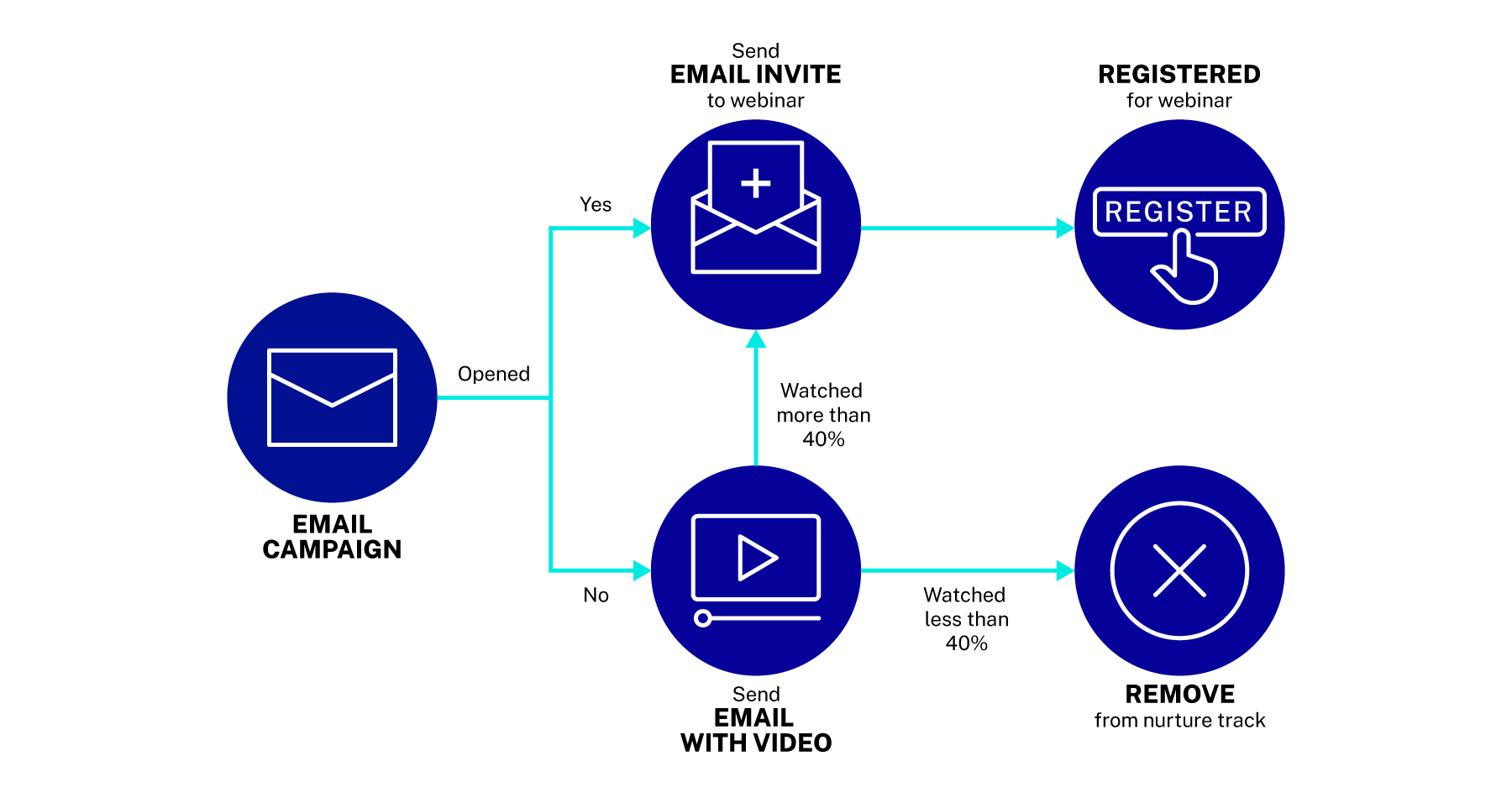With big ambitions and lots of planning, you led the charge to launch your company’s video marketing program. And it seems to be working. You’re seeing visitors spend longer amounts of time on pages that feature video. You’ve seen an uptick in engagements on social posts that contain video. And you may have even seen higher conversion rates on campaigns that incorporate video.
But as a marketer on the front line, you’ve also continued to see the clear shift in buyer preferences for a more personalized experience. Not to mention the new level of creativity today’s social videos exhibit.
With a number of successes under your belt, you’ve proven to marketing colleagues, executives, and sales teams that video marketing is worth the investment. But as the hype settles, you’re now tasked with building upon this foundation to achieve even higher performance and strategically align video with other marketing tactics.
Lucky for you, with these advanced marketing strategies, you can take your video initiatives to the next level and exponentially increase the impact of your overall marketing program.
INTEGRATE VIDEO ANALYTICS INTO YOUR AUTOMATION PLATFORM
Integrating your video analytics into Marketing Automation Platforms (MAPs) may be one of the most powerful tools for both optimizing video performance and increasing conversions. While there are numerous benefits to MAP integrations, there are three in particular that can have an immediate impact.
SEGMENTATION
Creating segments within your MAP based on viewing habits will help you offer a personalized approach to the buying process. Depending on your goals, there are a variety of rules you can apply to segmentation. Four examples of segmentations you could start with include:
- Which videos they have watched
- How many videos they have watched
- Interest level in certain videos (based on time spent viewing)
- The topics of the videos they’re watching
Imagine you’re promoting a webinar in an email campaign. A common tactic is to re-engage non-openers of the email invite with alternate content. In this case, that content could be a video on the same topic as the webinar to stimulate interest.
Rather than segmenting by opens or clicks, you could segment the recipients by how much of the video they watched. If they watched more than 40%, you could resend the email invite to this segment. If they watched less than 40%, it’s pretty clear they’re not interested and you can remove them from the nurture track.
TARGETING
Integration with your MAP will also give you valuable data to help you target various audiences with the content they’re most interested in. For example, you may notice trends in video consumption based on persona attributes like:
- Industry
- Title
- Function
- Seniority
Your analytics will help you uncover these trends and apply the learnings to future targeted campaigns that can personalize your approach.
LEAD SCORING
Video consumption habits can also indicate how close a prospect is to converting and which videos are most effective at guiding the buyer to the next stage. Your data can paint a clearer picture for you, but there are some key indicators you should consider relative to prospects who have already closed:
- Which videos are they watching?
- How long are they spending watching the videos?
- How many videos does the average MQL consume before becoming an SQL? Which ones?
- How do these trends compare with prospects who have converted?
Based on these answers, you’ll be able to add nuance to lead scores with specific video and consumption habits.
ARM YOUR SALES TEAM WITH THE DATA THEY NEED
Integration with MAPs not only benefits your lead nurturing efforts, it can support the sales reps tasked with creating touchpoints and follow-up conversations with buyers.
Just as important, the data gained from prospects’ watch habits can help fuel successful sales enablement programs. The analytics can help you determine which types of prospects are most interested in which topics and apply those insights to drive all types of content, not just video.
Simply put, by integrating with MAPs, you’ll be able to combine video analytics with other analytics from landing pages, email, and website visits. This holistic approach will give sales reps a clearer picture of a prospect than ever before.
Key questions that can help arm sales reps with the data they need to close deals include:
- Has the number of videos they’ve viewed increased recently?
- Which videos produce the most leads?
- At what point during the buyers’ journey do we notice the biggest uptick in video consumption?
- Are multiple people from the same organization watching videos?
- Which videos that the prospect watches have over an 80% completion rate
- Which ones are under 20%?
These questions can help sales reps better understand what’s most important to the buyer as well as what’s not.
OPTIMIZE YOUR SOCIAL VIDEOS
By now you understand that social video is pretty much table stakes in today’s competitive digital content environment. In fact, according to Hubspot, 67% of marketers say that sharing marketing videos on social media has the biggest ROI. Furthermore, Twitter states that tweets with video get 10X engagement.
However, the social landscape is littered with millions of brand videos that failed to reach their full potential. So while publishing social video is a normal practice among businesses, creating great videos that engage your audience is less common than we’d like to admit.
The good news is that with effective video marketing processes, you can increase the performance of not just your videos, but your social presence as a whole.
CREATE A SOCIAL VIDEO COMMAND CENTER
Integrating your social profiles into your video marketing platform is not only extremely efficient, it also helps optimize your video for maximum delivery on each specific platform. It gives you the ability to:
- Make specific edits for each social channel
- Automatically ensure that each video is uploaded with the right dimensions natively to each platform
- Save time by scheduling or auto-publishing your videos
All of these can be quickly achieved from within a single social video command center.
BUILD EFFICIENCIES INTO YOUR PROCESS
Just as there are many different types of social posts, you probably already have access to a variety of social videos. With categories ranging from product highlights to employee spotlights, webinar clips to tutorials and beyond, organizing for quick access becomes particularly important. By creating well-defined folders, you’ll be able to quickly sort, locate, and deliver the right video at the right time to the right audience.
Beyond the convenience of a well-organized video library, the most powerful video marketing tools also offer batch editing features for further efficiency and optimization. For example, if you’re creating a campaign around a specific product, you’ll likely be using videos from many different sources, like webinars, tutorials, and feature spotlights. With batch editing features, you’re able to quickly edit all of the videos in the series with just a few clicks.
Want to add a specific landing page URL for all videos in the series? Need to update the tags for all of them to include relevant keywords related to the series? Want to change the title of each video to include the name of the series? Batch editing makes it possible while saving time and ensuring consistency.
USE ANALYTICS TO UNDERSTAND PLATFORM PREFERENCES
One of the best things about the social ecosystem as a whole is the distinct culture and personality of each platform. This is clearly evident in video consumption preferences on a per-platform basis as well. While longer, more detailed videos will perform better on certain channels, others will see videos that are shorter and to the point perform better.
However, it can be a painstaking task to get a direct comparison, since each social platform will offer different video metrics. By integrating your social channels into a video marketing platform, you’ll have one set of consistent metrics to compare across all platforms.
Whatever the viewing trends may be, using consistent metrics will help you uncover which videos perform best on social across platforms as well as on specific ones. This insight will also be valuable for sales reps who are actively posting video on social. Understanding viewer preferences will help them better engage their unique audiences on each platform. Furthermore, understanding the topics, depth, and interest in your videos can also give you more data about the type of topics users prefer in general and can be applied to all types of content, not just video.
EXPAND YOUR REACH AND ENGAGEMENT WITH LIVESTREAMS
Livestreaming can significantly deepen your relationship with followers through an interactive format that allows users to be immersed in the experience. The real-time aspect of the videos gives users the chance to engage with you in ways they never could before. Add to that the interactive features you can incorporate into your videos, and you see how this can become a truly collective experience.
Whether you’re launching a new product or hosting fully digital conferences, the possibilities are endless. One has to look no further than the creativity shown during the COVID-19 pandemic for proof.
While going live for the first time can be scary, with a little preparation it offers a level of engagement that brands could not have dreamed of just a few short years ago. As you prepare your live video strategy, there are a few things to keep in mind.
UPTIME IS EVERYTHING
Going down in the middle of a livestream for even just a few seconds can spell disaster. Viewers may tune out without ever coming back to see if your video is back online. Make sure your livestreaming platform has the resources for preventing downtime by choosing one with a reputation for 99.99% uptime (bonus points if they offer live redundancy).
ON DEMAND IS EXPECTED
While some users may join your livestream, they may not all be able to stay for the entire program. Others may want to join but have prior or last-minute obligations that prevent them from doing so. Offer them the opportunity to watch at their own pace and on their timeline with on-demand viewing options.
For many, watching at their preferred time is no longer just a feature, but a necessity. As video technology has evolved from VCR to DVR to VOD, so too have user expectations. Today’s media companies are simply expected to offer live content on demand. And in a content-driven world, all companies are expected to act like media companies.
FAKING IT IS ACCEPTABLE
From broadcast delayed call-in segments to pre-recorded halftime shows, faking live has been an acceptable practice for decades. The reality is that live will always present variables outside of your control, and some may be too far for comfort (like product demos or customer Q&As).
When preparation isn’t enough, it’s time to de-risk your event with a simulated live broadcast. Live events are complex productions, but with a product like Brightcove’s Simulive, you can have all the benefits of live without the risk or complexity.
BOOST YOUR VIDEO MARKETING
Through MAP integration, marketing/sales alignment, advanced social videos, and livestreaming, you’ll see a bigger impact on your overall video marketing efforts. Furthermore, you’ll continue to discover the many ways that video analytics can provide important data points to fuel your entire marketing program.




